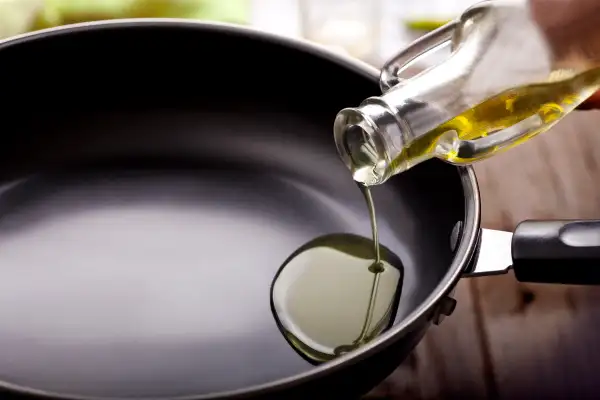That Olive Oil You're Cooking With? It's Probably Fake

A federal agency may start paying urgent attention to oil fraud. That’s because the liquid substance is routinely thinned out with other materials — or deliberately mislabeled. But the agency in question isn't the U.S. Department of Energy or the Environmental Protection Agency. The bureaucracy sampling and testing oil is the Food and Drug Administration. And the oil isn't Middle Eastern crude, but rather olive oil.
Whether you call it food fraud, counterfeiting, or fakery, what you buy in food stores and restaurants often isn’t what it seems.
Interpol recently announced that it had seized 10,000 metric tons and 1 million liters of "hazardous fake food and drink … in operations across 57 countries." The products included wine, whisky, vodka, beef and buffalo meat considered "unfit for human consumption," and peanuts repackaged and labeled as pine nuts.
According to some reports, more than 70% of the extra-virgin olive oil sold in the U.S., almost all of it imported, is mislabeled. A bottle bearing the words "extra virgin olive oil," which means fresh olives mechanically pressed without the use of chemicals, may not be the real deal. Instead, you may purchase something squeezed from the leftovers of making extra virgin, or oil extracted from rotting olives.
"There is an issue of counterfeit," says David Neuman, CEO of Greek olive oil company Gaea North America and an olive oil expert.
By the way, "bottled in Italy" doesn't mean grown in Italy. The oil may have been imported from elsewhere and packaged there. That is, if it's even olive oil. Sometimes real olive oil is blended with other types to make it go further and to increase the profits. Color doesn't give a clue, either.
Adulterated oil is just one example of food fraud. Some of the biggest items that are faked or mixed with fillers include coffee, tea, orange juice, and apple juice, according to Larry Olmsted, author of the book "Real Food, Fake Food."
"The largest fake food fraud scam uncovered in the US was [worth] $280 million," Olmsted said. "This was one ring of honey smugglers."
Yes, honey. Sometimes it's stretched with sweeteners, like corn syrup and beet sugar. "As testing becomes more sophisticated, the sources of sugar the honey cutters use are more sophisticated and closer chemically to honey," said Olmsted.
Do you buy shrimp? Often it comes from farms in Southeast Asia where it may be pumped with antibiotics "known not to be safe [and] specifically banned," Olmsted says.
Restaurants are no sure haven for the food lover. The Tampa Bay Times recently ran an investigative report about restaurants that claimed to purchase from local farms when the farmers said they hadn't sold to the chefs for years, if ever.
The problem with misleading menus isn't just a Florida problem. The Boston Globe used DNA testing to show that many restaurants and stores mislabeled fish, usually replacing a more expensive variety with something cheaper.
And Inside Edition bought lobster dishes at 28 restaurants across the country. Of them, 35% substituted something cheap for the lobster. Some of the substitutes were whiting, pollock, and langostino, "a less expensive seafood more closely related to hermit crab than lobster."
Sometimes the problems happen somewhere between where something was produced, raised, or caught and the final sale. It's called the supply chain and policing it can be decidedly difficult, as the electronics and apparel industries have learned the hard way.
Labeling laws are also an issue. If a government agency doesn't define a term, or if it treats it loosely, then there is room for trickery.
Ever eaten Angus beef? Olmsted said that under U.S. law, any cattle that has more than 50% black hide can be called Angus. "A lot of dairy cows are more than 50% black," he said. "They're not meant to be eaten, but when they get to be 13 or 14 or 15 and no longer produce milk, they're frequently ground up and put into hamburger." Grass fed cattle? Because there is no current definition for grass fed, it can be stretched to include any cattle that had ever eaten grass in their lifetime, which means virtually all of them.
And then there's Kobe beef. "In the United States there are only three places in the United States with licenses [to buy real Kobe beef from the Japanese production board]," Olmstead said. "Kobe beef costs on average around $50 an ounce. For the most part — a 99.9% chance — any [claim that] you see Kobe beef in a restaurant is a lie."
What can consumers do? First, recognize that if something seems too cheap to be real, it likely isn't. Next, get to know local producers when available. You might be surprised at what you can find. "Almost everywhere in the country you can buy honey from a producer," Olmstead said. "You can live in Brooklyn and buy local honey."
Finally, seek out the real thing, spend the extra money, and learn what it tastes like. If you've only had fake versions of a certain food, you won't know when someone is fooling you.
This article has been updated to reflect factual corrections.